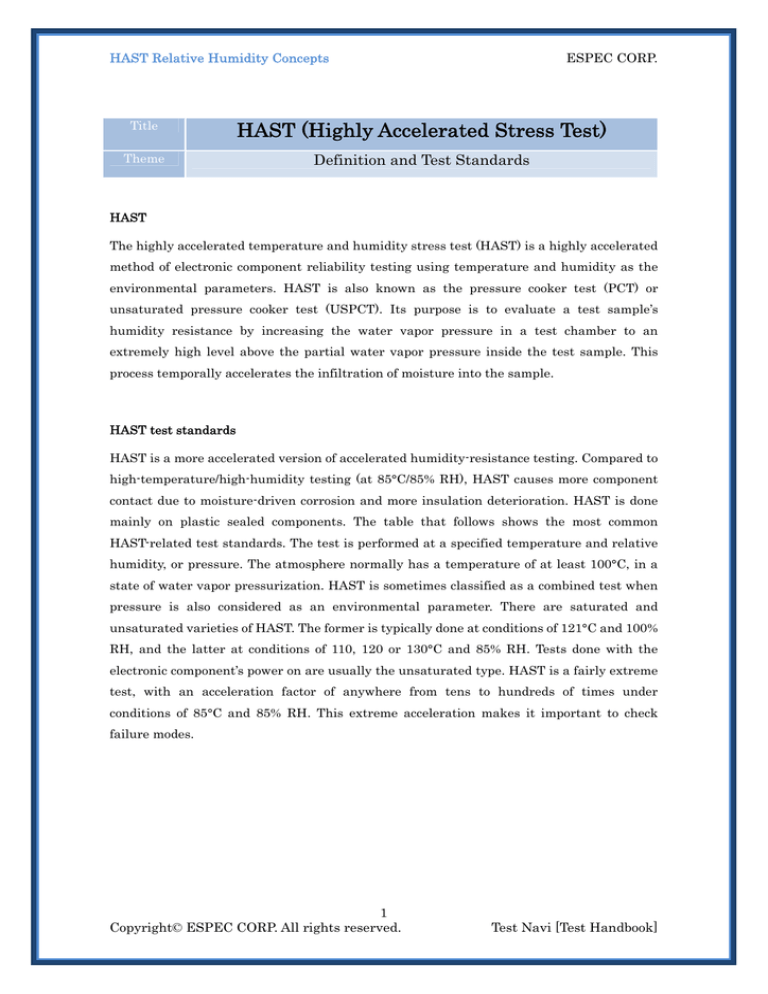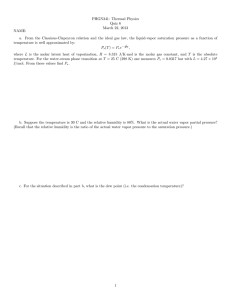HAST (Highly Accelerated Stress Test)
advertisement

HAST Relative Humidity Concepts ESPEC CORP. Title HAST (Highly Accelerated Stress Test) Theme Definition and Test Standards HAST The highly accelerated temperature and humidity stress test (HAST) is a highly accelerated method of electronic component reliability testing using temperature and humidity as the environmental parameters. HAST is also known as the pressure cooker test (PCT) or unsaturated pressure cooker test (USPCT). Its purpose is to evaluate a test sample’s humidity resistance by increasing the water vapor pressure in a test chamber to an extremely high level above the partial water vapor pressure inside the test sample. This process temporally accelerates the infiltration of moisture into the sample. HAST test standards HAST is a more accelerated version of accelerated humidity-resistance testing. Compared to high-temperature/high-humidity testing (at 85°C/85% RH), HAST causes more component contact due to moisture-driven corrosion and more insulation deterioration. HAST is done mainly on plastic sealed components. The table that follows shows the most common HAST-related test standards. The test is performed at a specified temperature and relative humidity, or pressure. The atmosphere normally has a temperature of at least 100°C, in a state of water vapor pressurization. HAST is sometimes classified as a combined test when pressure is also considered as an environmental parameter. There are saturated and unsaturated varieties of HAST. The former is typically done at conditions of 121°C and 100% RH, and the latter at conditions of 110, 120 or 130°C and 85% RH. Tests done with the electronic component’s power on are usually the unsaturated type. HAST is a fairly extreme test, with an acceleration factor of anywhere from tens to hundreds of times under conditions of 85°C and 85% RH. This extreme acceleration makes it important to check failure modes. 1 Copyright© ESPEC CORP. All rights reserved. Test Navi [Test Handbook] HAST Relative Humidity Concepts ESPEC CORP. Table 1 Common HAST-related standards (Note that standard conditions may be revised, so should be confirmed individually.) Name IEC (International standard) No. (Year/month of inception) Example test conditions Type* 60068-2-66 (1994/06) 60749-4 (2002/4) 22-A102-C (2008/6) JESD (JEDE US 22-A110C industrial (2009/1) standard) 22-A118 (2008/6) U Mainly used for: Compact electric/electronic components (mainly non-hermetically sealed components) U Semiconductors S Evaluating humidity resistance of non-hermetically sealed semiconductor devices U U Evaluating reliability of non-hermetically sealed semiconductor devices (with voltage application) Evaluating reliability of non-hermetically sealed semiconductor devices (without voltage application) Temp (C) RH (%) Test duration (hours) I JEITA (Japanese domestic industrial standard) C60068-2-66 (2001/11) ED-4701/100 Method 103 (2001/8) U U Compact electronic components (mainly non-hermetically sealed components) Evaluating durability of semiconductor devices used or stored in high-temperature/ high-humidity atmospheres III 110 85 96 192 408 120 85 48 96 192 130 85 24 48 96 130 85 96 110 85 264 A B C D E F 48 96 168 240 336 121 100 24 130 85 96 110 85 264 130 85 96 A 110 85 264 B I JIS (Japanese industrial standard) II II III 110 85 96 192 408 120 85 48 96 192 130 85 24 48 96 110 85 192 120 85 96 130 85 48 *U: unsaturated; S: saturated 2 Copyright© ESPEC CORP. All rights reserved. Test Navi [Test Handbook] HAST Relative Humidity Concepts ESPEC CORP. Title H HA AS ST T ((H Hiigghhllyy A Acccceelleerraatteedd S Sttrreessss T Teesstt)) Theme HAST Control Methods Espec’s HAST control methods are wet-and-dry bulb temperature control, unsaturated control and wetting saturation control. Wet-and-dry bulb temperature control measures and controls the test chamber temperature and humidity directly with a wet-and-dry bulb temperature sensor. Wetting saturation control and unsaturated control are used for testing under a condition of 100% relative humidity. The mechanism by which condensation forms on the test sample varies according to the control method. When using wetting saturation control for testing under a condition of 100% relative humidity, the test chamber heater is turned off, and only the humidifying heater is controlled. The environment resembles water being boiled in an airless atmosphere. When using unsaturated control, the test chamber heater being on causes a slight inclination toward unsaturation. The figure verified by ESPEC is about 98% (with no test sample in the chamber). Whether condensation forms on the test sample surface will be determined by the type of test sample, and the humidity during the temperature/humidity rise and fall. For this reason, common standards besides JEDEC (such as IEC and JIS) specify only relative humidity of 85%. We therefore recommend using test chambers only with full-condensation wetting saturation control, or wet-and-dry bulb temperature control. Pressure vessel Inner cylinder Test chamber heater Temperature sensor in chamber Door Test sample Agitating fan Air flow direction Cross-wick (provided on ‘M’ (multitype) models) Agitating fan motor Humidifying heater Humidifying water Wet bulb temperature sensor (provided on ‘M’ (multitype) models) Humidifying temperature sensor Figure 1 HAST test chamber structure 3 Copyright© ESPEC CORP. All rights reserved. Test Navi [Test Handbook] HAST Relative Humidity Concepts ESPEC CORP. Title H HA AS ST T ((H Hiigghhllyy A Acccceelleerraatteedd S Sttrreessss T Teesstt)) Theme For 25°C/60% RH Environment Below is a conceptual diagram of a constant temperature/humidity chamber. The relative humidity in a constant temperature/humidity chamber is defined by the formula below. The water vapor pressure in the chamber is measured by a wet-and-dry bulb thermometer. This instrument works on the principle that the evaporation rate of water varies according to the quantity of water vapor in the surrounding gas. It measures the wet bulb temperature, a different measurement of humidity from dew point (except when the humidity is 100%). Relative humidity in a constant temperature/humidity chamber (25°C/60% RH) 25°C/100% RH 25°C/60% RH Temperature in chamber: 25°C Water vapor pressure: 1.9 kPa Dry bulb temperature: 25°C Wet bulb temperature: 19.5°C (When air flow speed is 2.5 m/s.) Water molecule Air RH (%) = ≈ Water vapor pressure of moist air Mole fraction of water in moist air Mole fraction of water in saturated moist air Water vapor pressure of moist air Saturated water vapor pressure of water Temperature in chamber: 25°C Water vapor pressure of saturated moist air: About 3.2 kPa ×100 = × 100 = Water vapor pressure of saturated moist air 1.9 kPa 3.2 kPa ×100 ×100 = 60% Strictly speaking, a coefficient should be inserted to compensate for interactions between molecules of gaseous water and air, but since the total pressure is about 1 atmosphere, the interactions can be ignored. Figure 2 Constant temperature/humidity chamber relative humidity schematic diagram A 4 Copyright© ESPEC CORP. All rights reserved. Test Navi [Test Handbook] HAST Relative Humidity Concepts ESPEC CORP. C Coonncceepptt ooff R Reellaattiivvee H Huum miiddiittyy iinn aa C Coonnssttaanntt T Chhaam Teem Huum mppeerraattuurree//H miiddiittyy C mbbeerr Title Theme For 85°C/85% RH Environment In an 85°C/85% RH environment, the water vapor partial pressure and air partial pressure are each about 50 kPa. Relative humidity in a constant temperature/humidity chamber (85°C/85% RH) 85°C/85% RH Temperature in chamber: 85°C Water vapor pressure: 49.1 kPa Water molecule Air RH (%) = ≈ 85°C/100% RH Dry bulb temperature: 85°C Wet bulb temperature: 81°C (When air flow speed is 2.5 m/s.) Mole fraction of water in moist air Mole fraction of water in saturated moist air Water vapor pressure of moist air Saturated water vapor pressure of water ×100 = Temperature in chamber: 85°C Water vapor pressure of saturated moist air: About 57.8 kPa Water vapor pressure of moist air Water vapor pressure of saturated moist air ×100 49.1 kPa × 100 = 57.8 kPa ×100 = 85% Strictly speaking, a coefficient should be inserted to compensate for interactions between molecules of gaseous water and air, but since the total pressure is about 1 atmosphere, the interactions can be ignored. Figure 3 Constant temperature/humidity chamber relative humidity schematic diagram B 5 Copyright© ESPEC CORP. All rights reserved. Test Navi [Test Handbook] HAST Relative Humidity Concepts ESPEC CORP. Title H HA ST AS TR Reellaattiivvee H Huum miiddiittyy C Coonncceepptt Theme For 120°C/85% RH Environment Under these conditions, the HAST environment resembles water being boiled in an airtight space. The HAST relative humidity is defined by the formula below in IEC 60068-2-66. The water vapor pressure in the chamber is calculated by measuring the humidifying water temperature or wet bulb temperature, and considering that temperature to be the same as the dew point. This method assumes that the test space is filled only with water vapor. It has been shown experimentally that the humidifying water temperature, wet bulb temperature and dew point are roughly the same in a stable-period HAST environment of high temperature, humidity and pressure. HAST relative humidity (120°C/85% RH) 120°C/85% RH 120°C/100% RH Temperature in chamber: 120°C Water vapor pressure: 168.7 kPa Dry bulb temperature: 120°C Water molecule Temperature in chamber: 120°C Saturated water vapor pressure: 198.5 kPa Wet bulb temperature: 115°C Humidifying water temperature: 115°C Humidifying water temperature: 120°C Heating RH (%) = = Heating Water vapor pressure of moist air Saturated water vapor pressure of water 168.7 kPa 198.5 kPa ×100 ×100 = 85% Figure 4 HAST relative humidity schematic diagram 6 Copyright© ESPEC CORP. All rights reserved. Test Navi [Test Handbook]

